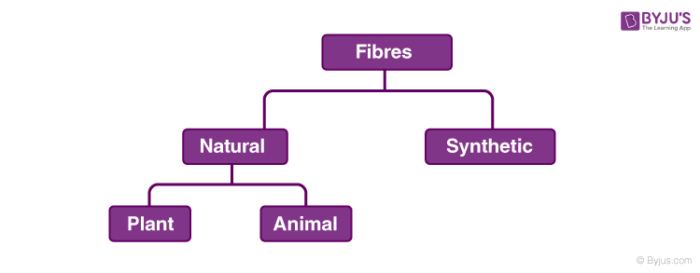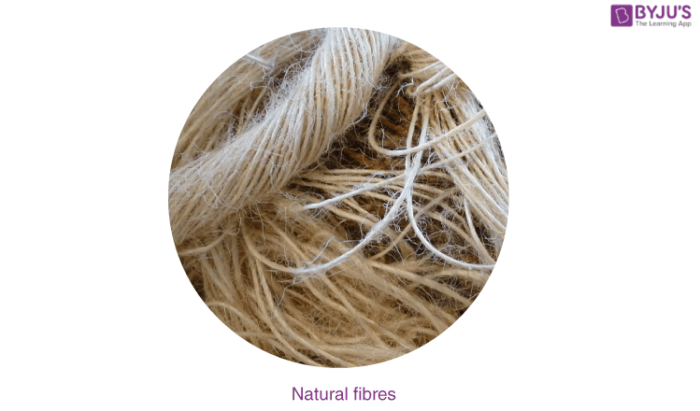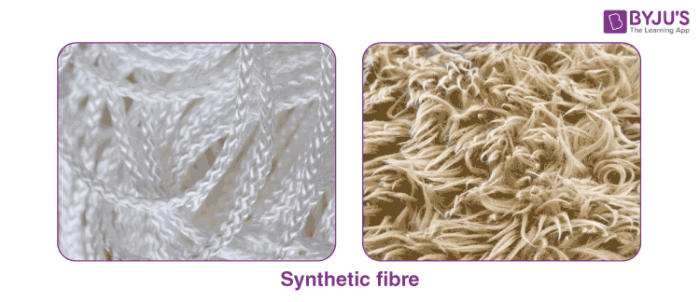What are Fibres?
Fibres are thread-like structures that are long, thin and flexible. These may be spun into yarns and then made into fabrics. There can be different types of fibres. On the basis of their origin, fibres are classified as natural fibres and synthetic fibres. Synthetic fibres can be produced in laboratory and can be cheaper compared to natural fibres but natural fibres are much more comfortable.
Table of Content

Recommended Videos on Fibres

Read More:
Natural Fibres

Natural fibres are the fibres that are obtained from plants, animals or mineral sources. Some examples are cotton, silk, wool etc. Natural fibres can again be divided into two types based on their source i.e. plants and animals.
Examples of Natural Fibres
1. Animal fibres: These are the fibres that are obtained from animals. For example Wool, silk etc.
- Wool: Wool is a natural textile fibre obtained from sheep, goats and camels. It traps a lot of air. Air is a bad conductor of heat. This makes clothes made from wool useful in winter.
- Silk: Silk is also a natural textile fibre which is obtained from silkworms. The rearing of silkworms to obtain silk is known as sericulture. Silk is mainly used for manufacturing clothes. Woven silk fibres are used for the construction of parachutes and bicycle tires
2. Plant fibres: These are the ones that are obtained from plants. These fibres are extracted from the plants to make fabrics.
- Cotton: It is one of the plant fibres that are used to make clothes. It is a soft staple fibre that is found as a balls around the seeds in a cotton plant. Cotton is used to make soft, breathable, and durable textile.
- Jute: It is a vegetable fibre that is soft, shiny and spun into coarse strong threads. Jute fibre is used for packaging a wide range of agricultural and industrial commodities that require bags, sacks, packs, and wrappings.
Synthetic Fibres

Synthetic fibres are man-made polymers designed to make a fabric. Polymers are obtained when many small units are joined together chemically.
Some of the examples of synthetic fibres are:
- Rayon: It is made from wood pulp. It is also known as artificial silk as it has characteristics resembling silk. Rayon is mainly used in clothing, carpets, medical dressings and for insulation.
- Nylon: It was the first synthetic fibre. It is used in the making of ropes, sleeping bags, parachutes, different types of clothes, etc. It is one of the strongest fibres known to us.
Advantages of Synthetic Fibres:
- They can be washed and dried quickly.
- They are easy to maintain.
- They are cheaper than natural fibres.
- Easily available.
- Do not wrinkle easily and are very durable.
Frequently Asked Questions – FAQs
What are examples of natural fibres?
Seed hairs, such as cotton, stems (or bast) fibres, such as flax and hemp, leaf fibres, such as sisal, and husk fibres, such as coconut, are all examples of plant fibres. Wool, hair, and secretions, such as silk, are examples of animal fibres.
What are natural fibres in short?
Plants, animals, and geological processes create natural fibres, often known as natural fibres. They can be utilized in composite materials where the orientation of the fibres affects the characteristics. Natural fibres can be flattened into sheets and used to produce paper or felt.
What are different natural fibres?
Seed hairs, such as cotton, stem (or bast) fibres, such as flax and hemp, leaf fibres, such as sisal, and husk fibres, such as coconut, are all examples of plant fibres. Wool, hair, and secretions, such as silk, are examples of animal fibres.
Which is man-made fibre?
Synthetic and cellulosic man-made fibres (MMF) are the two most common kinds. Cellulosic fibres are made from wood pulp while synthetic fibres are made from crude oil. Polyester, acrylic, and polypropylene are the most common synthetic staple fibres. Viscose, modal, and other cellulosic fibres are examples of cellulosic fibre.
What are the properties of fibre?
The kind of fibre influences essential qualities such as strength, durability, handling, elasticity, dyeability, lustre, friction properties, moisture absorption, heat isolation, and abrasion resistance, as well as all the physical and chemical properties of fibres and their end-products.
To know more about natural and synthetic fibres download BYJU’S – The Learning App.

Comments